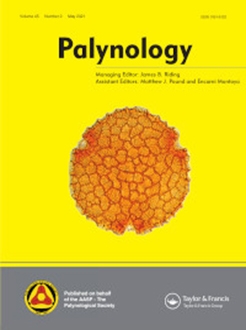Diverse and well-preserved marine palynomorphs occur in the Padeha, Khoshyeilagh, and Mobarak formations in the Khoshyeilagh area, northeastern Alborz, northern Iran. The marine palynomorph assemblages consist of acritarchs, prasinophytes, and chitinozoans, comprising 27 genera and 46 species. In addition, the studied sediments contain 20 species of algae, foraminifera, and corals allocated to 11 genera. The vertical distribution of acritarchs and chitinozoans allows the erection within these sediments of three local assemblage zones. Biozone I occurs in the upper part of the Padeha Formation and the basal part of the Khoshyeilagh Formation, suggesting a Frasnian–early Famennian age; Biozone II is present in the Khoshyeilagh Formation and indicates a Famennian age. Biozone III, which occurs in the basal part of the Mobarak Formation, suggests a Tournaisian age for this interval. Many of the palynomorph species, such as Crassiangulina tessellita, Daillydium pentaster, Deltotosoma intonsum, Gorgonisphaeridium discissum, Helosphaeridium microclavatum, Horologinella horologia, Papulogabata annulata, Somphophragma miscellum, and Veryhachium downiei, are closely comparable with coeval assemblages recorded from Australia, Ireland, Portugal, Saudi Arabia, North Africa, South America, and North America. This indicates the close relationship of the Iranian Platform to other parts of the northern Gondwana and southern Laurentian domain during the Late Devonian–Early Carboniferous. Moreover, results of similarity indices of marine microphytoplankton indicate a relatively high degree of similarity between the assemblages of the Khoshyeilagh area and those elsewhere in the Alborz Mountains and the Kerman Basin. Palaeontological evidence indicates that the Khoshyeilagh Formation was deposited in a low-energy, somewhat offshore, normal marine environment within the Alborz Basin, along the Palaeo-Tethys Ocean during this time interval. Furthermore, based on palynological data gathered from Iran, it can be concluded that Iran was an island during this interval of time.
How to translate text using browser tools
3 May 2021
The Biostratigraphy of the Upper Devonian and Lowermost Carboniferous of the Khoshyeilagh Area, Northeastern Alborz, Iran
Fatemeh Taherian,
Fatemeh Vaez-Javadi,
Seyed Hamid Vaziri
ACCESS THE FULL ARTICLE
It is not available for individual sale.
This article is only available to subscribers.
It is not available for individual sale.
It is not available for individual sale.

Palynology
Vol. 45 • No. 2
May 2021
Vol. 45 • No. 2
May 2021
acritarchs
Alborz
biostratigraphy
Chitinozoans
corals
Devonian: Carboniferous
Iran




